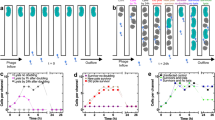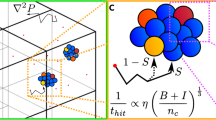Abstract
The model of bacteriophage predation on bacteria in a chemostat formulated by Levin et al. (Am Nat 111:3–24, 1977) is generalized to include a distributed latent period, distributed viral progeny release from infected bacteria, unproductive adsorption of phages to infected cells, and possible nutrient uptake by infected cells. Indeed, two formulations of the model are given: a system of delay differential equations with infinite delay, and a more general infection-age model that leads to a system of integro-differential equations. It is shown that the bacteria persist, and sharp conditions for persistence and extinction of phages are determined by the reproductive ratio for phage relative to the phage-free equilibrium. A novel feature of our analysis is the use of the Laplace transform.
Similar content being viewed by others
References
Beretta E, Kuang Y (1998) Modeling and analysis of a marine bacteriophage infection. Math Biosci 149: 57–76
Beretta E, Sakakibara H, Takeuchi Y (2002) Analysis of a chemostat model for bacteria and bacteriophage. Vietnam J Math 30(suppl): 459–472
Beretta E, Sakakibara H, Takeuchi Y (2003) Stability analysis of time delayed chemostat models for bacteria and virulent phage, dynamical systems and their applications in Biology (Cape Breton Island, NS, 2001). Fields Inst Commun, vol 36. American Mathematical Society, Providence, pp 45–58
Beretta E, Solimano F, Tang Y (2002) Analysis of a chemostat model for bacteria and virulent bacteriophage. Discret Contin Dyn Syst B 2: 495–520
Busenberg SN, Cooke KL (1980) The effect of integral conditions in certain equations modelling epidemics and population growth. J Math Biol 10: 13–32
Campbell A (1961) Conditions for existence of bacteriophages. Evolution 15: 153–165
DeLeenheer P, Smith HL (2003) Virus dynamics: a global analysis. SIAM J Appl Math 63: 1313–1327
Ellis E, Delbrück M (1939) The growth of bacteriophage. J Physiol 22: 365–384
Hale JK, Verduyn Lunel SM (1993) Introduction to functional differential equations. Springer, New York
Hewitt E, Stromberg K (1965) Real and abstract analysis. Springer, Berlin, Heidelberg
Hino Y, Murakami S, Naito T (1991) Functional differential equations with infinite delay. Lecture Notes in Mathematics, vol 1473. Springer, New York
Hirsch WM, Hanisch H, Gabriel J-P (1985) Differential equation models for some parasitic infections: methods for the study of asymptotic behavior. Comm Pure Appl Math 38: 733–753
Lenski R, Levin B (1985) Constraints on the coevolution of bacteria and virulent phage: a model, some experiments, and predictions for natural communities. Am Nat 125: 585–602
Levin B, Stewart F, Chao L (1977) Resource-limited growth, competition, and predation: a model, and experimental studies with bacteria and bacteriophage. Am Nat 111: 3–24
Marcheva M, Thieme HR (2003) Progression age enhanced backward bifurcation in an epidemic model with superinfection. J Math Biol 46: 385–424
Nowak MA, May RM (2000) Virus dynamics. Oxford University Press, New York
Payne R, Jansen V (2001) Understanding bacteriophage therapy as a density-dependent kinetic process. J Theor Biol 208: 37–48
Perelson AS, Nelson PW (1999) Mathematical analysis of HIV-1 dynamics in vivo. SIAM Rev 41: 3–44
Rabinovitch A, Hadas H, Einav M, Melamed Z, Zaritsky A (1999) Model for bacteriophage T4 development in Escherichia coli. J Bacteriol 181: 1677–1683
Ruess W, Summers W (1994) Operator semigroups for fuctional differential equations with delay. Trans Am Math Soc 341: 695–719
Sartwell PE (1950) The distribution of incubation periods of infectious diseases. Am J Hyg 51: 310–318
Sartwell PE (1966) The incubation period and the dynamics of infectious disease. Am J Epid 83: 204–318
Schrag S, Mittler J (1996) Host-parasite coexistence: the role of spatial refuges in stabilizing bacteria–phage interactions. Am Nat 148: 348–377
Smith HL (2008) Models of virulent phage growth with application to phage therapy. SIAM J Appl Math 68: 1717–1737
Smith HL (2010) An introduction to delay differential equations with applications to the life sciences. Texts in Applied Math, vol 57. Springer, New York
Smith HL, Thieme HR (2011) Dynamical systems and population persistence. Graduate Studies in Mathematics, vol 118. American Mathematical Society, Providence
Smith HL, Waltman Paul (1995) The theory of the chemostat. Cambridge University Press, Cambridge
Thieme HR (1990) Semiflows generated by Lipschitz perturbations of non-densely defined operators. Differ Integr Equ 3: 1035–1066
Thieme HR (2003) Mathematics in population biology. Princeton University Press, Princeton
Thieme HR, Tridane A, Kuang Y (2008) An epidemic model with post-contact prophylaxis of distributed length I. Thresholds for disease persistence and extinction. J Biol Dyn 2: 221–239
Thieme HR (2009) Distributed susceptibility: a challenge to persistence theory in infectious disease models. Disc Cont Dyn Sys B 12: 305–323
Trevino R, Smith HL (2009) Bacteriophage infection dynamics: multiple host binding sites. Math Model Nat Phenom 4: 111–136
Weitz J, Hartman H, Levin S (2005) Coevolutionary arms race between bacteria and bacteriophage. Proc Natl Acad Sci 102: 9535–9540
Author information
Authors and Affiliations
Corresponding author
Additional information
Hal L. Smith is supported by NSF Grant DMS-0918440.
Horst R. Thieme is supported by NSF Grant DMS-0715451.
Rights and permissions
About this article
Cite this article
Smith, H.L., Thieme, H.R. Persistence of bacteria and phages in a chemostat. J. Math. Biol. 64, 951–979 (2012). https://doi.org/10.1007/s00285-011-0434-4
Received:
Revised:
Published:
Issue Date:
DOI: https://doi.org/10.1007/s00285-011-0434-4




